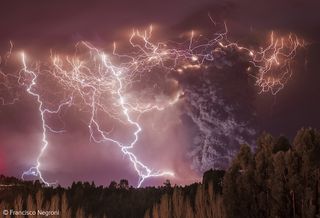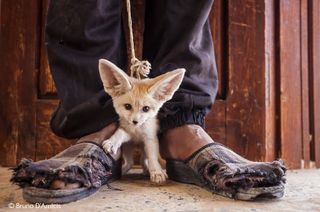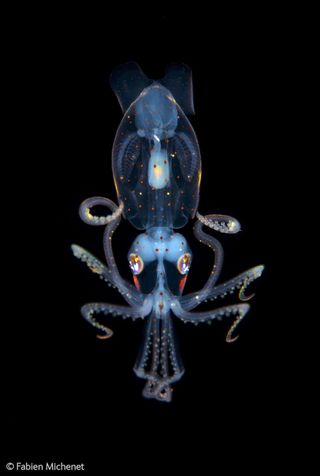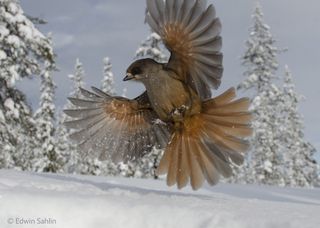Photos: Amazing Shots from 'Wildlife Photographer of the Year' Contest
A striking black-and-white photo of lions took first prize at the 50th Wildlife Photographer of the Year competition, but an international panel of judges honored a handful of other gifted artists of all ages. The Natural History Museum in London will showcase the photos through August 2015, and the exhibit will also travel to other venues around the world. Here are some amazing photos from the contest. [Read full story on the photography contest]
The 'Last Great Picture'

This award-winning photo shows five lionesses sleeping with their cubs just after the female lions fought off one of the males in the group. (Photo credit: Michael ‘Nick’ Nichols / Wildlife Photographer of the Year 2014.)
Stinger in the sun

A scorpion raised its stinger as a warning when the young photographer neared, but 8-year-old Carlos Perez Naval's bravery paid off. His photo won first prize in the "10 years and under" division of the 50th Wildlife Photographer of the Year Competition.
The photo, taken near Torralba de los Sisones in northeast Spain, captures the glow of the afternoon sun on the common yellow scorpion. A double exposure allowed the sun to shine on the scorpion from the photo's upper corner. (Photo credit: Carlos Perez Naval / Wildlife Photographer of the Year 2014.)
Apocalypse
Sign up for the Live Science daily newsletter now
Get the world’s most fascinating discoveries delivered straight to your inbox.

Francisco Negroni headed to the Puyehue National Park in southern Chile after the Puyehue-Cordón Caulle volcanic complex began erupting. What he saw looked like the apocalypse. From his viewpoint on a distant hill, Negroni witnessed flashes of lightning and the glow from the molten lava illuminate the billowing smoke.
"It was the most incredible thing I have seen in my life," he said in a statement.
Volcanic lightning, known as a "dirty thunderstorm," is rare and short-lived, and is likely caused by static electrical charges from fragments of hot-red rock, ash and vapor rising high in the volcanic plume as they crash together. The Cordón Caulle eruption disrupted air travel in the southern hemisphere and spewed about 110 million tons of ash into the atmosphere. (Photo credit: Francisco Negroni / Wildlife Photographer of the Year 2014.)
The world in our hands

After a great struggle, a young great white shark suffocated after a hook pierced its body. Rodrigo Friscione Wyssmann took this photo off Magdalena Bay on the Pacific coast of Baja California, Mexico. He noticed that a great weight had pulled down a fisherman's buoy. The hook that caught the shark was intended to catch blue and mako sharks.
"I was deeply shocked," he said in a statement. "Great whites are amazing, graceful and highly intelligent creatures. It was such a sad scene that I changed the image to black and white, which felt more dignified."
Many other surface-baited longlines kill tens of thousands of endangered animals each year. (Photo credit: Rodrigo Friscione Wyssmann/ Wildlife Photographer of the Year 2014.)
The price they pay

In this photo, a teenager in southern Tunisia is trying to sell a 3-month-old fennec fox, captured from its den in the Sahara Desert. It's illegal to catch or kill the foxes in Tunisia, but several complex causes have made the practice widespread. Some of these factors include high unemployment, poor education, lack of enforcement of conservation laws, ignorant tourists and tour companies, habitat destruction and the socio-political legacy of the "Arab Spring" revolts.
Photographer, Bruno D'Amicis, gained the trust of villagers in Tunisia, Algeria and Morocco to track the fox and raise awareness about its plight. (Photo credit: Bruno D'Amicis / Wildlife Photographer of the Year 2014.)
Little squid

During a night dive off the coast of Tahiti, Fabien Michenet, of France, found this juvenile sharpear enope squid. Measuring about an inch (3 centimeters) long, the squid floated motionless about 66 feet (20 meters) below the surface, likely hunting for food. The squid's bioluminescent organs can be seen brightly in the image. (Photo credit: Fabien Michenet / Wildlife Photographer of the Year 2014.)
Touche

The sword-billed hummingbird, whose beak is longer than its body (excluding its tail), makes a statement with its bill. Jan van der Greef, of the Netherlands, came across this standoff during a trip to Ecuador. The bird's beak can reach nectar from long, tube-like flowers. This particular hummingbird (right) defended its favored red angel trumpet flowers and bird feeders, near the photographer's lodge, from a territorial collared inca. (Photo credit: Jan van der Greef / Wildlife Photographer of the Year 2014.)
Snowbird

During a skiing holiday in Sweden, Edwin Sahlin learned that Siberian jays like to eat leftover lunch scraps of cheese and sausage. On one occasion, Sahlin dug a deep pit, scattered food around its edges, and waited for a hungry bird to fly nearby. He captured its rusty colors in this photograph. (Photo credit: Edwin Sahlin / Wildlife Photographer of the Year 2014.)
The long embrace

Anton Lilja photographed the mating ritual of frogs near his home in Västerbotten, Sweden. Frog eggs swell up once they make contact with the water, so a female frog needs to find a nearby male frog to fertilize them the instant they leave her body. The male holds onto the female in a tight embrace, called amplexus, which can last for days.
Lilja let his flash reflect off the water as he caught a pair of mating frogs, the male with his blue throat behind the female. (Photo credit: Anton Lilja / Wildlife Photographer of the Year 2014.)
Green Dragon

A 3-foot-long (1 meter) green iguana appeared one day when Will Jenkins was relaxing with his family in Costa Rica. Jenkins quickly grabbed his camera.
"I love stories about dragons, and I wanted a big picture for my wall that would make me smile every day," he said in a statement. "I also wanted to impress my dad and brother with a shot of the biggest iguana I’d ever seen."
After sunbathing for 20 minutes in the sun, the iguana headed to the beach. "It made me realize that you should always have your camera with you, just in case," Jenkins said. (Photo credit: Will Jenkins / Wildlife Photographer of the Year 2014.)
Follow Laura Geggel on Twitter @LauraGeggel and Google+. Follow Live Science @livescience, Facebook & Google+.

Laura is the archaeology and Life's Little Mysteries editor at Live Science. She also reports on general science, including paleontology. Her work has appeared in The New York Times, Scholastic, Popular Science and Spectrum, a site on autism research. She has won multiple awards from the Society of Professional Journalists and the Washington Newspaper Publishers Association for her reporting at a weekly newspaper near Seattle. Laura holds a bachelor's degree in English literature and psychology from Washington University in St. Louis and a master's degree in science writing from NYU.
